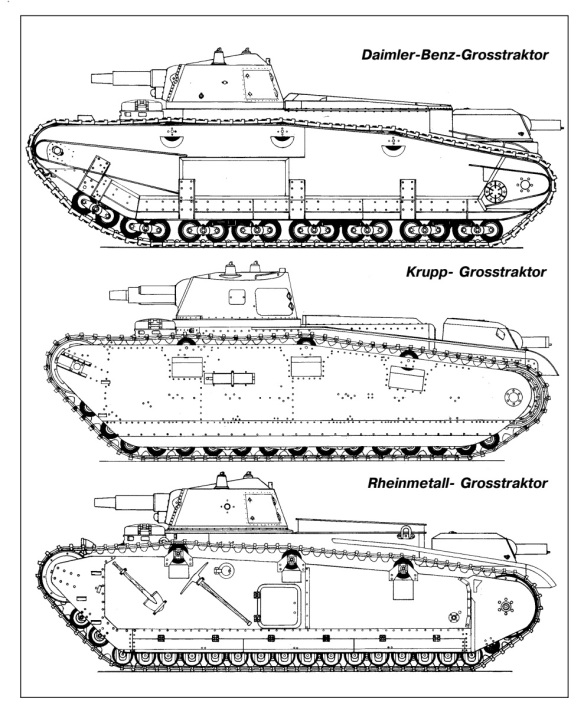In 1925, the Weapons Office produced conceptual requirements for a 16-ton vehicle with a top speed of 25mph, 14mm of armour and a turret mounted 75mm gun. Three firms responded and as early as 1926 these three German companies (Rheinmetall-Borsig, Daimler-Benz and Krupp) each produced a single prototype armed with a large 75-millimeter cannon (the Großtraktor, “large tractor”, was so codenamed to veil the true purpose of the vehicle). Krupp and Rheinmetall-Borsig had a lengthy history of arms production while Daimler-Benz was an automobile manufacturer. None of these companies gave the project a high priority.
The Großtraktor was designed as a heavy breakthrough vehicle. The prototype vehicles had differences; however what follows was true of at least one or more of the models. The main armament was the same short 7.5 cm gun initially used on the Panzer IV; with secondary armaments including multiple machine guns. The approximate weight was 16 tons. The engine was a six-cylinder engine, in the 250-260 hp range.
The following may have applied only to the Rheinmetall-Borsig and Krupp designs: a machine gun was placed at the rear of the tank, behind the turret; and the tank commander sat not in the turret, but in the hull to the right of the driver. The Großtraktor prototypes were constructed of mild steel and two were tested at the Kama testing facility near Kazan in the USSR, called by the Germans Panzertruppenschule Kama (Armoured Troops School Kama and used from 1926 to 1933).
One result of the experimentation in Kazan was that the German Army Motorization Department felt compelled to field two tank types corresponding to the Großtraktor and the Leichttraktor; codenamed the BW and ZW. The BW reference being for Battalionführerwagen, or the Battalion commander’s vehicle; which was intended to be a fire support vehicle. The BW was to accompany the ZW, the Zugführerwagen, or Section commander’s vehicle intended to act as the core battle tank. The work on the Großtraktor led to the Neubaufahrzeug, a similar heavy tank design. The prototypes were decommissioned in 1937; at least one ended up as a memorial to early armoured regiments.
The Neubaufahrzeug was ordered from Rheinmetall-Borsig in 1933, and was to be a development of their earlier Grosstraktor to provide the German Army with a 20 ton multi-turreted main tank. Tests on two mild steel prototypes in 1934 led to the construction of three armoured vehicles in 1935. These were fitted with a Krupp-designed turret and gun mount which simplified construction and set the 7.5cm KwK and 3.7cm KwK side by side.
Vehicles 1 and 2 had mild steel armour and the rounded Rh-B turret and vertical gun mount. Before being used in action in 1940, vehicles 3, 4 and 5 were refitted with an extra turret similar to that of the Pz Kpfw I, but armed with only one MG34.
The prototypes were used by the tank training school at Putlos until 1940. The three armoured vehicles were attached to the Pz Abt z b V 40 (z b V == for special employment). In April 1940, they were shipped direct to Oslo in Norway and were used in action during that month. One vehicle was destroyed and the two surviving Nbfz were returned to Germany at the end of 1940.
http://www.achtungpanzer.com/leichte-traktor-grosstraktor-i-ii-iii-neubaufahrzeug-pzkpfw-v-vi.htm
